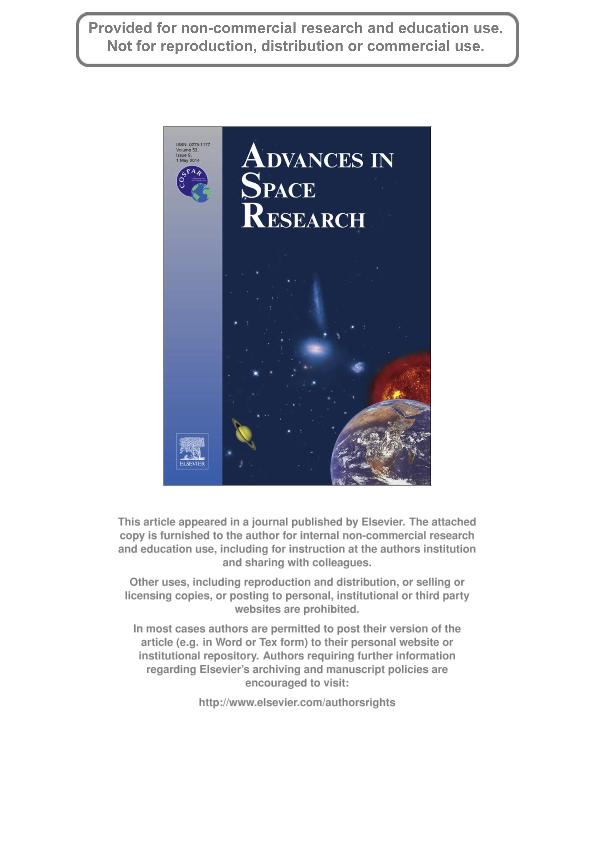Mostrar el registro sencillo del ítem
dc.contributor.author
Mansilla, Gustavo Adolfo

dc.date.available
2016-08-18T18:29:26Z
dc.date.issued
2014-04
dc.identifier.citation
Mansilla, Gustavo Adolfo; Some ionospheric storm effects at equatorial and low latitudes; Elsevier; Advances In Space Research; 53; 9; 4-2014; 1329-1336
dc.identifier.issn
0273-1177
dc.identifier.uri
http://hdl.handle.net/11336/7244
dc.description.abstract
In this paper, the response of the equatorial and low latitude ionosphere to three intense geomagnetic storms occurred in 2002 and 2003 is reported. For that, critical frequency of F2-layer foF2 and the peak height hmF2 hmF2 for the stations Jicamarca (11.9°S), Ascension Is (7.92°S) and Tucuman (26.9°S) are used. The results show a “smoothing” of the Equatorial Anomaly structure during the development of the storms. Noticeable features are the increases in foF2 before the storm sudden commencement (SC) at equatorial latitudes and the southern crest of the Equatorial Anomaly. In some cases nearly simultaneous increases in foF2 are observed in response to the storm, which are attributed to the prompt electric field. Also, positive effects observed at equatorial and low latitudes during the development of the storm seem to be caused by the disturbance dynamo electric field due to the storm-time circulation. Increases in foF2 above the equator and simultaneous decreases in foF2 at the south crest near to the end of a long-duration main phase are attributed to equatorward-directed meridional winds. Decreases in foF2 observed during the recovery phase of storms are believed to be caused by composition changes. The results indicate that the prompt penetration electric field on the EA is important but their effect is of short lived. More significant ionospheric effects are the produced by the disturbance dynamo electric field. The role of storm-time winds is important because they modify the “fountain effect” and transport the composition changes toward low latitudes.
dc.format
application/pdf
dc.language.iso
eng
dc.publisher
Elsevier

dc.rights
info:eu-repo/semantics/openAccess
dc.rights.uri
https://creativecommons.org/licenses/by-nc-nd/2.5/ar/
dc.subject
Geomagnetic Storms
dc.subject
Equatorial Anomaly
dc.subject
Ionosphere
dc.subject.classification
Meteorología y Ciencias Atmosféricas

dc.subject.classification
Ciencias de la Tierra y relacionadas con el Medio Ambiente

dc.subject.classification
CIENCIAS NATURALES Y EXACTAS

dc.title
Some ionospheric storm effects at equatorial and low latitudes
dc.type
info:eu-repo/semantics/article
dc.type
info:ar-repo/semantics/artículo
dc.type
info:eu-repo/semantics/publishedVersion
dc.date.updated
2016-08-17T15:40:43Z
dc.journal.volume
53
dc.journal.number
9
dc.journal.pagination
1329-1336
dc.journal.pais
Países Bajos

dc.journal.ciudad
Amsterdam
dc.description.fil
Fil: Mansilla, Gustavo Adolfo. Universidad Nacional de Tucuman. Facultad de Ciencias Exactas y Tecnologia. Departamento de Fisica; Argentina. Consejo Nacional de Investigaciones Científicas y Técnicas. Centro Científico Tecnológico Tucumán; Argentina
dc.journal.title
Advances In Space Research

dc.relation.alternativeid
info:eu-repo/semantics/altIdentifier/url/http://www.sciencedirect.com/science/article/pii/S0273117714001410
dc.relation.alternativeid
info:eu-repo/semantics/altIdentifier/doi/http://dx.doi.org/10.1016/j.asr.2014.02.020
dc.relation.alternativeid
info:eu-repo/semantics/altIdentifier/doi/10.1016/j.asr.2014.02.020
Archivos asociados
